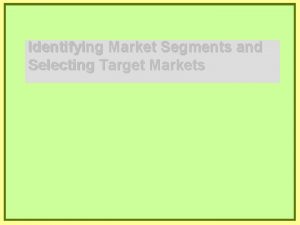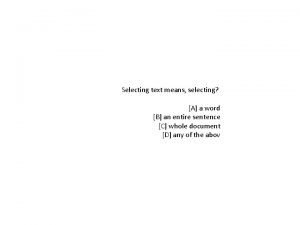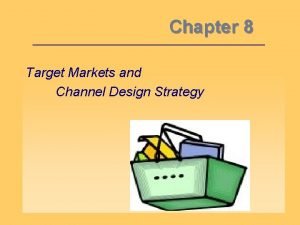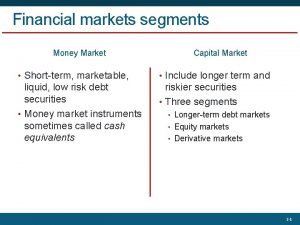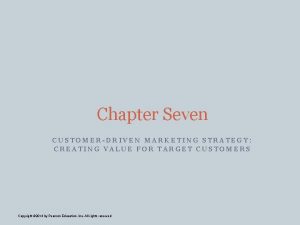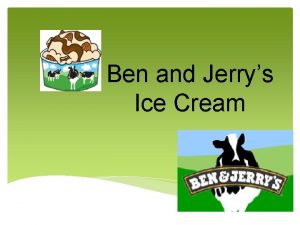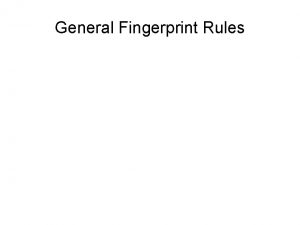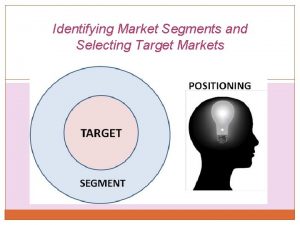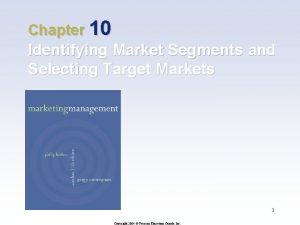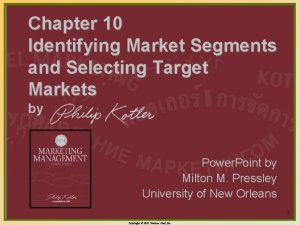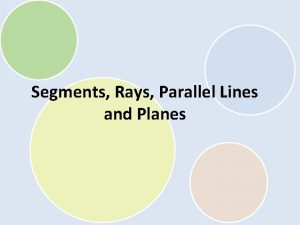Identifying Market Segments and Selecting Target Markets Dont































- Slides: 31

Identifying Market Segments and Selecting Target Markets

“Don’t buy market share. Figure out how to earn it. ”

Objectives of this Presentation § We focus on the following questions: § How can a company identify the segments that make up a market? § What criteria can a company use to choose the most attractive target markets?

Target Marketing § Target marketing requires marketers to take three major steps: § Identify and profile distinct groups of buyers who differ in their needs and preferences (market segmentation). § Select one or more market segments to enter (market targeting). § For each target segment, establish and communicate the key distinctive benefit(s) of the company’s market offering (market positioning).

Levels and Patterns of Market Segmentation § Levels of Market Segmentation § Mass marketing § Micromarketing § Segment marketing § Market segment § Sector § Flexible market offering § Naked solution § Discretionary options

Levels and Patterns of Market Segmentation § Niche Marketing § Niche § Local Marketing § Individual Customer Marketing § Mass-customization § Choiceboard § Customerization § Segments § Individuals

Levels and Patterns of Market Segmentation § Patterns for Market Segmentation § Preference segments § Homogeneous preferences § Diffused preferences § Clustered preferences § Natural market segments § Concentrated marketing

Levels and Patterns of Market Segmentation § Market Segmentation Procedure § Needs-based market segmentation approach § Market partitioning § Brand-dominant hierarchy § Nation-dominant hierarchy

Chem. Station’s Web site offers customers solutions to their problems, not just products.

Table 10 -1: Steps in Segmentation Process Description 1. Needs-Based Segmentation Group customers into segments based on similar needs and benefits sought by customer in solving a particular consumption problem. 2. Segment Identification For each needs-based segment, determine which demographics, lifestyles, and usage behaviors make the segment distinct and identifiable (actionable). 3. Segment Attractiveness Using predetermined segment attractiveness criteria (such as market growth, competitive intensity, and market access), determine the overall attractiveness of each segment. 4. Segment Profitability Determine segment profitability. 5. Segment Positioning For each segment, create a “value proposition” and product-price positioning strategy based on that segment’s unique customer needs and characteristics.

Levels and Patterns of Market Segmentation § Criteria for Effective Segmentation § Measurable § Substantial § Accessible § Differentiable § Actionable

Segmenting Consumer and Business Markets § Geographic Segmentation § Demographic Segmentation § Age and Life-Cycle Stage

Table 10 -2: Major Segmentation Variables for Consumer Markets Geographic Region Pacific, Mountain, West North Central, West South Central, East North Central, East South Central, South Atlantic, Middle Atlantic, New England City or metro size Under 5, 000; 5, 000 -20, 000; 20, 000 -50, 000; 50, 000100, 000; 100, 000 -250, 000; 250, 000 -500, 000; 500, 000 -1, 000; 1, 000 -4, 000; 4, 000 or over Density Urban, suburban, rural Climate Northern southern Demographic Age Under 6, 6 -11, 12 -19, 20 -34, 35 -49, 50 -64, 65+ Family size 1 -2, 3 -4, 5+

Segmenting Consumer and Business Markets § Bases for Segmenting Consumer Markets § Geographic Segmentation § Demographic Segmentation § Age and Life-Cycle Stage

Sega’s homepage: Not just games

Segmenting Consumer and Business Markets § Life Stage § Gender § Income § Generation § § The Depression Cohort The World War II Cohort The Post-War Cohort Leading-Edge Baby Boomer Cohort § Trailing-Edge Baby Boomer Cohort § Generation X Cohort § The Generation Y Cohort

Segmenting Consumer and Business Markets § Lifestage Analytic Matrix § § Lifestages Physiographics Emotional effects Socioeconomics § Social Class § Psychographic Segmentation § Lifestyle § Time-constrained § multitasking § Money-constrained

Segmenting Consumer and Business Markets § Personality § “Brand personality” examples: § Sincere § Exciting § Competent § Sophisticated § Rugged § Values § Core values

Segmenting Consumer and Business Markets § Behavioral Segmentation § Occasions § Critical life events or transitions § Benefits § Mobil has identified five segments and their sizes § Road Warriors 16% § Generation F 27% § True Blues 16% § Home Bodies 21% § Price Shoppers 20%

Segmenting Consumer and Business Markets § User Status § Usage Rate § Loyalty Status § § Hard-core loyals Split loyals Shifting loyals Switchers § Buyer-Readiness Stage § Attitude

Segmenting Consumer and Business Markets § Multi-Attribute Segmentation (Geoclustering) § Four PRIZM clusters § § American Dreams Rural Industria Gray Power Country Squires § Targeting Multiple Segments

Segmenting Consumer and Business Markets § Bases For Segmenting Business Markets

Table 9 -3: Major Segmentation Variables for Business Markets Demographic 1. Industry: Which industries should we serve? 2. Company size: What size companies should we serve? 3. Location: What geographical areas should we serve? Operating Variables 4. Technology: What customer technologies should we focus on? 5. User or nonuser status: Should we serve heavy users, medium users, light users, or nonusers? 6. Customer capabilities: Should we serve customers needing many or few services? Purchasing Approaches 7. Purchasing-function organization: Should we serve companies with highly centralized or decentralized purchasing organizations? 8. Power structure: Should we serve companies that are engineering dominated, financially dominated, and so on?

Segmenting Consumer and Business Markets § Business buyers seek different benefit bundles based on their stage in the purchase decision process. 1. 2. 3. First-time prospects Novices Sophisticates

Segmenting Consumer and Business Markets § Rangan, Moriarty, and Swartz studied a mature commodity market, steel stamping, and four business segments 1. 2. 3. 4. Program buyers Relationship buyers Transaction buyers Bargain hunters

Segmenting Consumer and Business Markets § Rackman and Vincentis proposed a segmentation scheme that classifies business buyers into three groups § Price-oriented customers (transactional selling) § Solution-oriented customers (consultative selling) § Strategic-value customers (enterprise selling)

Market Targeting § Evaluating and Selecting the Market Segments § § § Single-Segment Concentration Selective Specialization Product Specialization Market Specialization Full Market Coverage § Undifferentiated marketing § Differentiated marketing

Market Targeting § Higher costs using differentiated marketing include: § § § Product modification cost Manufacturing cost Administrative cost Inventory cost Promotion cost

Market Targeting § Additional Considerations § Ethical Choice of Market Targets § Supersegment § Segment-By-Segment Invasion Plans

Figure 9 -3: Segment-by-Segment Invasion Plan

Market Targeting § Intersegment Cooperation
 Primary target market and secondary target market
Primary target market and secondary target market Identifying market segments and targets chapter 9
Identifying market segments and targets chapter 9 Identifying market segments and targets
Identifying market segments and targets Identifying market segments and targets chapter 9
Identifying market segments and targets chapter 9 Identifying market segments and targets
Identifying market segments and targets Segment by segment invasion
Segment by segment invasion Single segment concentration
Single segment concentration Selecting text means
Selecting text means Dont ask dont tell political cartoon
Dont ask dont tell political cartoon Dont laugh at me dont call me names
Dont laugh at me dont call me names Identification of the system for development
Identification of the system for development Adjective
Adjective Adjective clause identification
Adjective clause identification Identify the essential
Identify the essential Market segmentation objectives
Market segmentation objectives Target market and channel design strategy
Target market and channel design strategy Selecting investment in global market
Selecting investment in global market Selecting investment in global market
Selecting investment in global market Leader follower challenger nicher
Leader follower challenger nicher Money market and capital market
Money market and capital market Market segmentation and targeting
Market segmentation and targeting Attractive market segments
Attractive market segments Magic wall interactive surfaces market segments
Magic wall interactive surfaces market segments Common market segments
Common market segments The nfl targets several different market segments
The nfl targets several different market segments Supply & demand matching
Supply & demand matching Target market of ice cream
Target market of ice cream Charles and keith products
Charles and keith products Recruiting for international assignments
Recruiting for international assignments Rules governing delta location
Rules governing delta location Selecting and storing eggs
Selecting and storing eggs Strategies for acquiring it applications
Strategies for acquiring it applications






